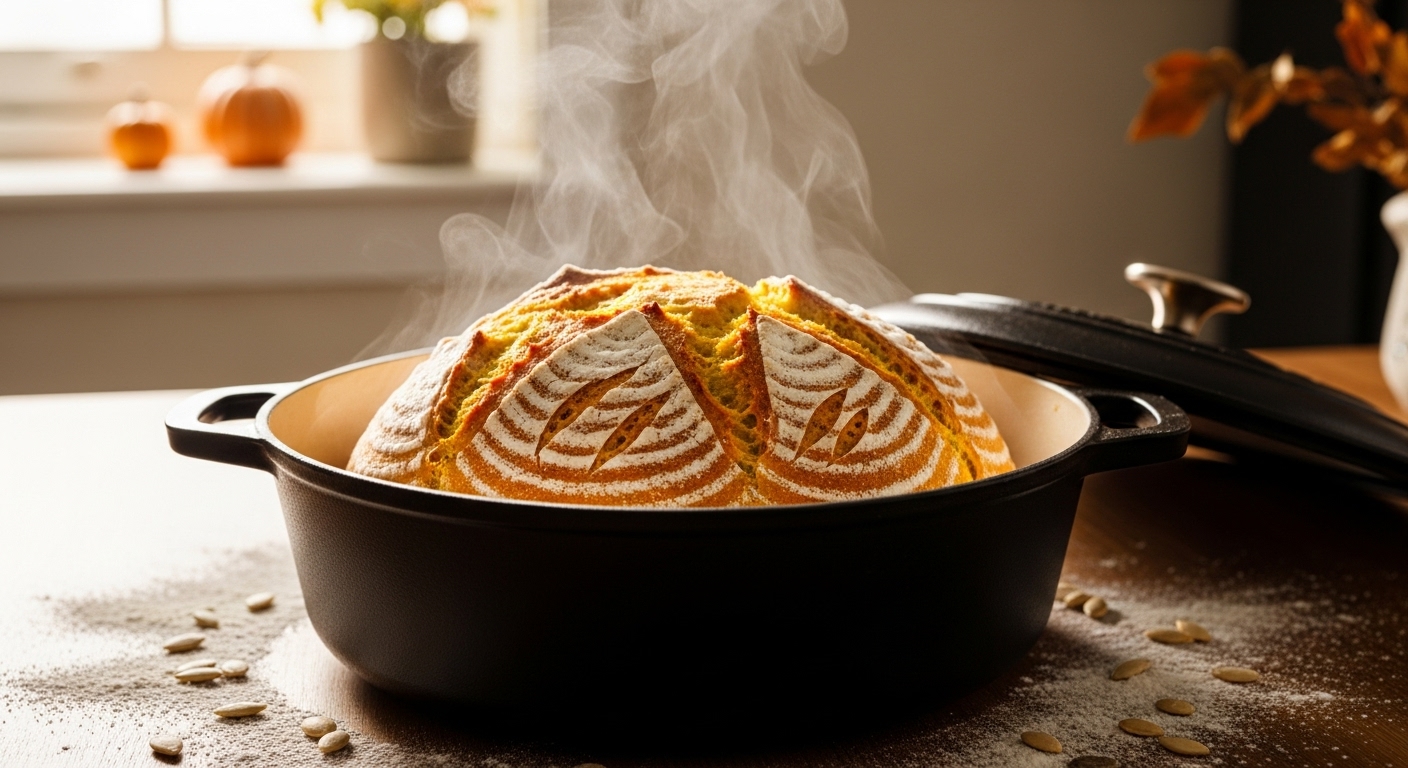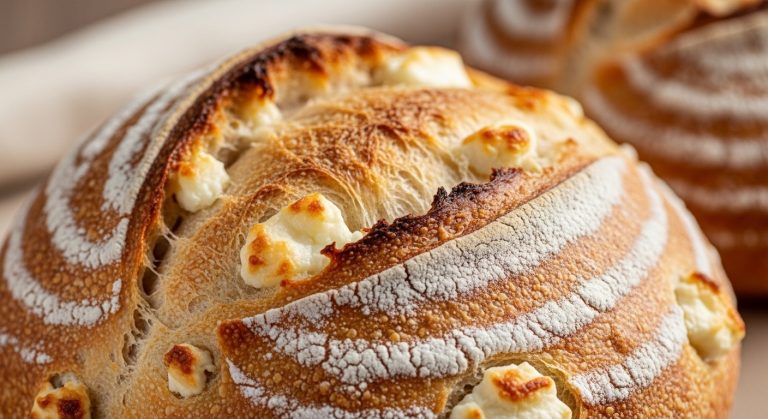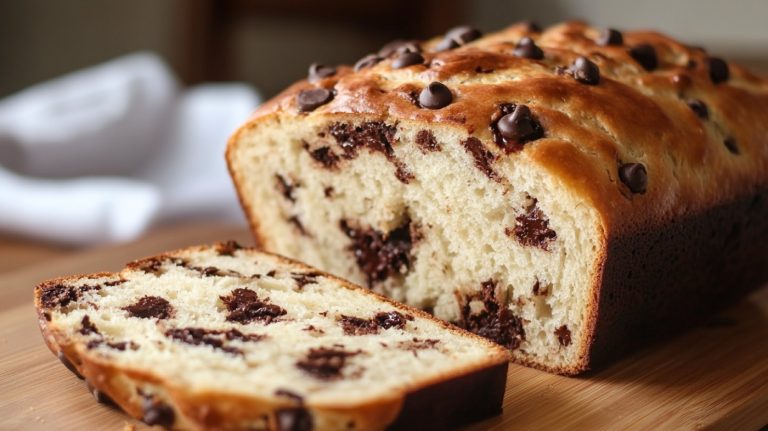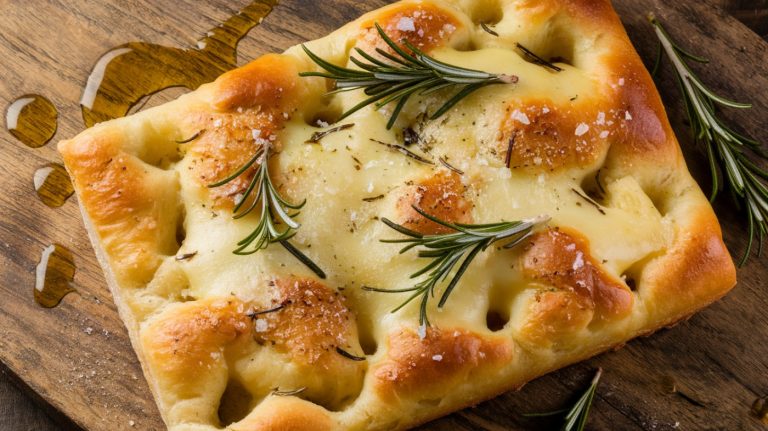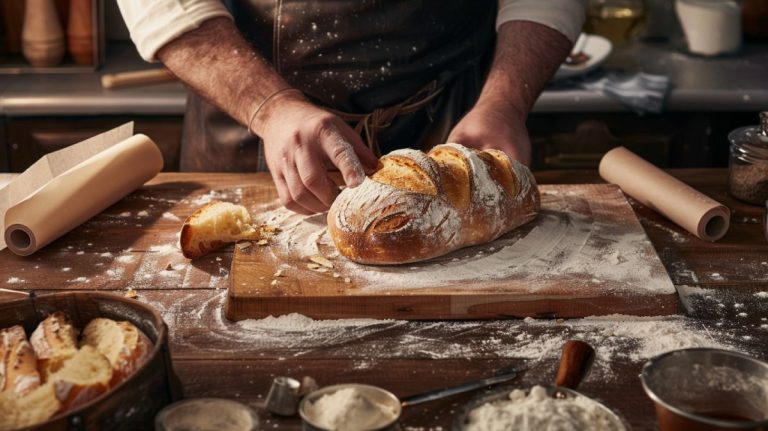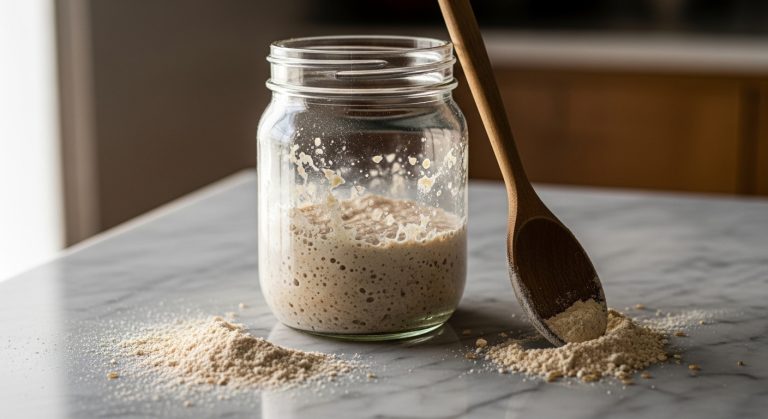Pumpkin Spice Sourdough Bread: Cozy Fall Flavor
You’ll love making pumpkin spice sourdough bread by blending tangy, bubbly starter with rich pumpkin puree and warming spices like cinnamon and nutmeg. Knead until elastic, then watch the dough rise with those lively bubbles signaling perfect fermentation.
Bake it covered in a Dutch oven for a crisp crust and tender crumb. Adding sweeteners or nuts elevates flavor complexity. Keep going—there’s plenty more to master for that cozy, autumn-perfect loaf.
Key Takeaways
- Combine bread flour, pumpkin puree, spices, and an active sourdough starter for a moist, flavorful pumpkin spice sourdough dough.
- Proper fermentation until doubled with visible bubbles ensures an open crumb and balanced texture in the bread.
- Shape the dough, proof at room temperature, and chill briefly to maintain form before baking in a preheated Dutch oven.
- Bake covered at 450°F–475°F for oven spring, then uncovered to develop a crusty, spiced exterior and tender crumb.
- Enhance flavor with cinnamon, nutmeg, maple syrup, and optional add-ins like cranberries or walnuts for texture and warmth.
Pumpkin Spice Sourdough Artisan Bread Recipe Table
| Step | Ingredients | Quantity | Action | Tips for Success |
|---|---|---|---|---|
| 1 | Bread flour | 400 g | Combine with pumpkin puree, water, and starter | Use high-protein flour for better gluten structure |
| 2 | Pumpkin puree | 200 g | Blend into dough for moisture & flavor | Canned or fresh strained puree works |
| 3 | Active sourdough starter | 100 g | Mix in for natural leavening | Feed starter 5–12 hrs before use |
| 4 | Water | 180–200 ml | Adjust for dough hydration | Reduce slightly to account for pumpkin moisture |
| 5 | Salt | 8 g | Add after autolyse for flavor balance | Sea salt enhances flavor |
| 6 | Brown sugar or maple syrup | 30 g | Mix in for sweetness & caramel notes | Helps crust caramelize beautifully |
| 7 | Pumpkin spice mix (cinnamon, nutmeg, cloves) | 2–3 tsp | Add during kneading | Adjust spice balance to taste |
| 8 | Optional add-ins: walnuts, cranberries | 50–70 g | Fold in after bulk fermentation | Adds crunch & bursts of flavor |
| 9 | Bake | 450–475°F, Dutch oven | Bake covered 25 min, uncovered 20 min | Internal temp should reach ~190°F |
| 10 | Cooling | — | Cool on wire rack | Wait at least 1 hr before slicing |
Ingredients and Their Roles
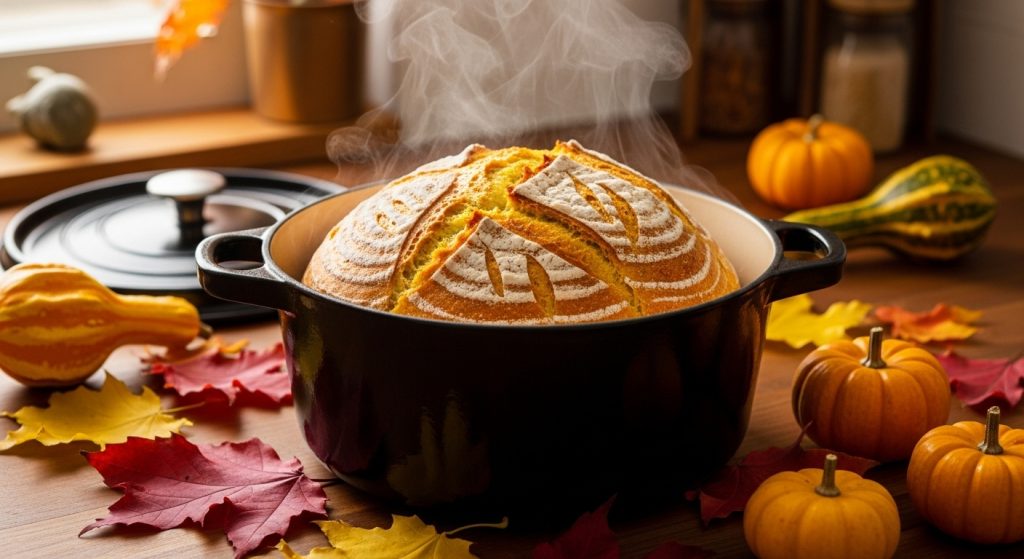
Although pumpkin spice sourdough bread combines familiar autumnal flavors, its success hinges on carefully chosen ingredients that each play a crucial role.
You’ll typically start with bread flour for strong gluten development, ensuring your bread holds its shape and has a chewy crumb. Proper hydration and dough handling, as explored in key sourdough baking techniques, are essential to achieving the perfect texture.
Sometimes, all-purpose flour softens the texture, balancing tenderness with structure. Pumpkin puree isn’t just for moisture and sweetness—it enriches texture and interacts with your sourdough starter, feeding the yeast and adding natural sugars and fiber. For activation, it’s important to use all-purpose flour rather than bread flour to prepare the starter effectively.
To boost rise and crumb in quicker recipes, baking powder or baking soda often join the mix. Freezing and thawing considerations can also impact the final flavor and texture, so proper storage techniques help preserve the bread’s quality if not consumed immediately. This harmonious blend of flours, pumpkin, and leavening agents creates a bread that’s moist, flavorful, and beautifully textured.
Preparing Your Sourdough Starter and Levain
When you prepare your sourdough starter and levain for pumpkin spice bread, you set the foundation for that perfect rise and rich flavor. Start with an active starter fed within 5-12 hours, bubbly and tangy, signaling robust yeast activity.
Your levain should ripen at room temperature for 4-12 hours, peaking with maximum volume and bubbles. Maintain roughly 100% hydration for balanced fermentation, adjusting slightly for pumpkin’s moisture.
Mix levain gently into liquids before flour to preserve yeast vitality and ensure even distribution.
Using a mix like Krusteaz Sourdough Bread Mix, known for its high-quality flours, can enhance your bread’s texture and flavor.
| Step | Key Action | Tip |
|---|---|---|
| Starter Activation | Feed with equal parts flour + water | Use within 5-12 hours |
| Levain Preparation | Mix starter + flour + water | Follow 1:1:1 weight ratio |
| Ripening Time | Let rise 4-12 hours | Peak volume = ready to use |
| Hydration Control | Maintain ~100% hydration | Adjust for pumpkin moisture |
| Mixing Levain | Stir into liquids first | Avoid deflating gas bubbles |
Mixing and Kneading the Pumpkin Spice Dough
As you combine the ripe levain, bread flour, water, canned pumpkin puree, salt, and brown sugar, you’ll notice the dough’s sticky texture coming to life, rich with moisture from the pumpkin’s custardy nature.
Use a wooden spoon or Danish dough whisk to blend until no dry flour remains. It’s important to mix all ingredients until a shaggy dough forms before kneading. Utilizing a kitchen scale with precision increments can help achieve consistent ingredient ratios for perfect dough hydration.
Mix ripe levain, flour, water, pumpkin puree, salt, and brown sugar until the dough is moist and sticky.
To handle stickiness, wet your hands often and avoid adding too much flour, which toughens the dough. Employ gentle kneading or stretch and folds for 3 to 5 minutes to develop elasticity without overworking.
Remember to:
- Keep dough covered during rests to retain moisture
- Use pumpkin puree for a tender, hydrated crumb
- Add pumpkin spice after initial kneading for depth
- Let brown sugar enhance caramelization
- Use a dough scraper for shaping and folding
Fermentation and Proofing Tips
Mastering fermentation and proofing is key to unblocking the full flavor and texture potential of your pumpkin spice sourdough. Start with a bulk fermentation after mixing, performing two rounds of stretch and folds spaced 30 to 60 minutes apart to build gluten strength. Using an active sourdough starter fed within the last 24 hours will provide a robust rise and enhance flavor development.
Aim for dough volume to roughly double, signaling active yeast and gas retention. Incorporate pumpkin puree carefully—it boosts moisture and sugars but can accelerate fermentation and soften dough.
Cold fermentation in the fridge for 16 to 24 hours, or up to 48, deepens flavor and refines texture, while preventing over-proofing. This long fermentation process is ideal for traditional sourdough breads.
For final proof, shape the dough into a banneton, cover to retain moisture, and proof at room temperature for 2 to 8 hours or cold overnight.
Watch for dough readiness; well-timed fermentation ensures a tender crumb and complex taste.
Baking Techniques for Perfect Crust and Crumb
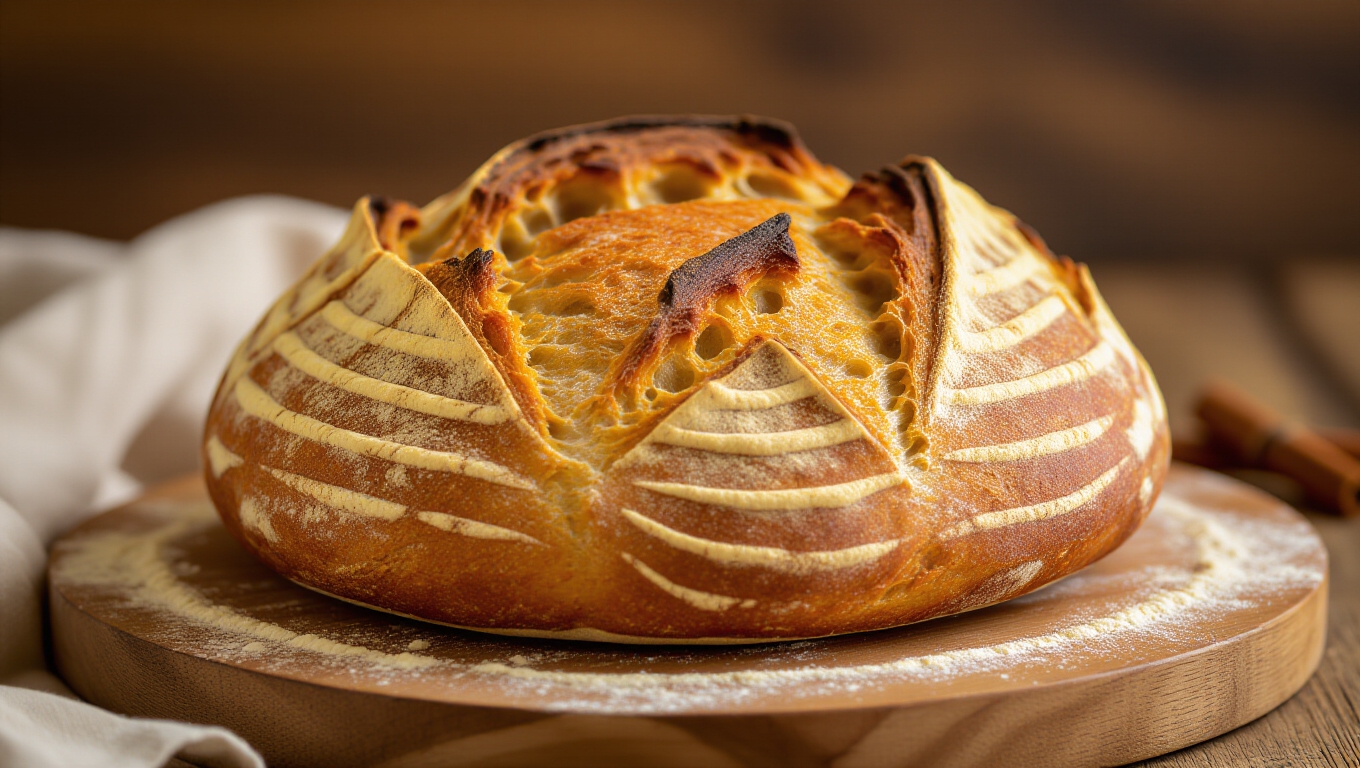
You’ll want to master the balance of dough hydration, especially with pumpkin puree adding extra moisture, to achieve that perfect crumb texture. Using a high-protein bread flour helps support the structure needed for a chewy yet soft crumb.
Scoring your loaf just right guides its expansion and creates those beautiful crusty “ears.” Baking at a high temperature inside a covered Dutch oven traps steam, making your crust glossy and crackly every time.
Optimal Oven Temperature
When you dial in the optimal oven temperature for pumpkin spice sourdough bread, you open the perfect balance between a crisp, caramelized crust and a tender, flavorful crumb. You’ll need to consider how heat interacts with moisture from pumpkin puree and the delicate spices that can easily burn.
Aim for a temperature that nurtures oven spring yet preserves spice aroma.
Here’s what to keep in mind:
- Start high (450°F–475°F) in a Dutch oven to trap steam and boost crust rise.
- Lower heat (around 350°F) for loaf pans to avoid toughening crust.
- Remove the cover near the end to brown crust without drying.
- Monitor internal bread temperature (~190°F) to confirm doneness.
- Adjust based on your oven’s quirks and spice sensitivity.
- For best flavor and texture, ensure your sourdough starter is active and well-fed before baking.
Dough Hydration Balance
Adjusting oven temperature sets the stage, but the true magic in pumpkin spice sourdough bread comes from balancing dough hydration. Pumpkin puree adds moisture, pushing hydration to 75-80%, higher than usual. Monitoring the dough temperature during mixing ensures optimal yeast activity and fermentation.
You’ll need to reduce water accordingly—start with less during autolyse and add gradually. Too much water makes the dough sticky and hard to shape, risking a gummy crumb.
Yet, that silky, supple dough thanks to pumpkin’s fiber makes handling easier when folding in spices or nuts. This hydration level softens the crust, trading crunch for a tender, deep golden exterior.
Managing moisture carefully prevents sogginess despite sugars and fats enriching the dough. The dough is ready when it has doubled in size, with large bubbles visible underneath, indicating proper fermentation and readiness for baking dough fermentation indicators.
By mastering this balance, you ensure a loaf with an open crumb, stable texture, and that irresistible pumpkin-spiced character. Proper kneading techniques also develop the gluten network necessary for that soft, elastic dough.
Scoring and Steam Use
Although balancing dough hydration sets the foundation, mastering scoring and steam use elevates your pumpkin spice sourdough to bakery-level perfection.
Scoring controls how your loaf expands, creating those signature ears and an open crumb, while steam crafts a glossy, crisp crust that’s simply irresistible. Before scoring, it’s helpful to slightly stiffen the dough by chilling it in the refrigerator or freezer for about 10 minutes, which helps prevent spreading and defines the shape better.
To nail this process:
- Score the dough just before baking, about ½ inch deep, using a sharp blade.
- Opt for creative designs to add charm and control gas release.
- Bake covered in a preheated Dutch oven at 475°F to trap steam for 40–55 minutes.
- Remove the lid toward the end to caramelize and crisp the crust.
- Cool on a wire rack to preserve texture.
Follow these steps, and you’ll transform your bread’s crust and crumb into something truly stunning.
Flavor Enhancements and Creative Variations
Since pumpkin spice sourdough bread thrives on complex layers of flavor, you can elevate your loaf by experimenting with spice blends, sweeteners, and texture enhancers that complement the natural earthiness of pumpkin. Consider also how hydration levels affect the moisture and texture of your dough for optimal results.
Try adjusting your pumpkin spice mix—adding extra cinnamon or a pinch of turmeric for warmth and color.
Swap brown sugar for maple syrup or honey to introduce caramel or floral notes while enhancing crumb moisture.
Incorporate dried cranberries and crunchy walnuts for bursts of texture and flavor contrast.
Swirling a cinnamon-sugar butter through the dough creates beautiful ribbons and intensified spice pockets.
For a festive touch, shape your loaf like a pumpkin or glaze it with powdered sugar icing. Using a mature sourdough starter ensures the bread develops the signature tang and structure that define traditional sourdough.
These creative variations make your pumpkin spice sourdough not only delicious but visually mesmerizing and unique every time.
Frequently Asked Questions
Can I Substitute Canned Pumpkin Puree With Fresh Pumpkin?
You can absolutely substitute fresh pumpkin puree for canned, but be ready to tweak your recipe. Fresh puree is lighter, more moist, and has a subtler flavor, so you’ll want to strain it well to remove fibrous bits and adjust liquids accordingly.
Since fresh pumpkin is less intense, adding a bit more spice or sugar helps balance flavors. It takes more effort but rewards you with a fresher, nuanced taste that canned just can’t match.
How Do I Store Leftover Pumpkin Spice Sourdough Bread?
You’ll want to keep your leftover bread fresh by storing it properly. At room temperature, wrap it airtight in plastic or a ziplock bag to prevent drying and staling—avoid leaving cut sides exposed over 12 hours.
If you won’t finish it soon, refrigerate in an airtight container to slow mold but watch for dryness.
For longer storage, slice and freeze it tightly wrapped; thaw at room temperature before enjoying.
Is It Possible to Make This Recipe Gluten-Free?
You can absolutely turn this recipe gluten-free, like swapping the roots of a tree yet keeping its branches strong. Use a gluten-free sourdough starter and replace wheat flour with sorghum, tapioca, or rice flour blends.
Add xanthan gum or psyllium husks to give your dough that elastic, chewy feel. Carefully ferment overnight and adjust hydration—your bread will keep that tender, spiced magic without any gluten worries.
Can I Freeze the Dough Before Baking?
You can freeze dough before baking, but for best results, freeze it after shaping and bulk fermentation. This helps maintain gluten structure and guarantees better oven spring.
Wrap it tightly in plastic wrap or use a banneton covered with a plastic bag to prevent freezer burn.
Thaw the dough slowly in the fridge overnight, then proof it fully before baking.
Avoid freezing too early to keep your bread’s texture and rise ideal.
How Do I Adjust Baking Times for High-Altitude Locations?
At high altitude, you’ll want to increase your oven temperature by about 15-25°F to help your bread set properly despite lower air pressure.
Cut your baking time by 5-10 minutes since moisture evaporates faster up there. Keep a close eye on crust color—if it browns too quickly, tent it with foil.
Always use a toothpick or knife to check doneness rather than relying solely on time.
Fall in Love with Pumpkin Spice Sourdough Bread
Baking pumpkin spice sourdough bread is like crafting a cozy autumn hug you can taste. As you nurture your starter, knead the dough, and watch it rise, every step connects you deeply to the magic of baking.
Don’t rush the process—embrace each moment with patience and care. Once it’s out of the oven, that warm, spiced aroma will remind you why homemade bread is truly unforgettable.
You’re not just baking bread; you’re creating comfort.

